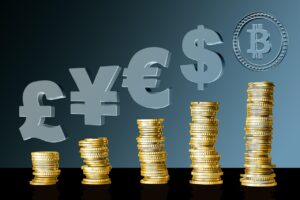What drives price movements in the foreign exchange market?
What suits one trader may not suit another. It’s about finding the style that best suits the individual. We recommend to start trading with Majors, it is usually the easiest. Trading currencies with larger currency pairs, known as “majors“, is a major advantage according to many technical analysts who believe that it is easier to master price movements in the foreign exchange market. On the one hand, the spread is significantly lower and you can be “in the money” already after 1 second when trading such liquid currencies. Another big advantage is also that technical analysis often works better on heavily traded currencies, as more people follow them and there is more activity. Simply put, it is often easier to do analysis on these currency pairs.
Beginners in the foreign exchange market
Forex beginners often don’t see anything special about the EUR/USD currency pair, or even worse, they start trading with exotic currency pairs with low liquidity. Unfortunately, choosing a currency pair is not that simple. There are rules and characteristics; they are inherent in every currency pair. The main things that we need to pay attention to when choosing a currency pair are: the volatility, the predictability of the currency pair and other characteristics.
The pound is affected by.
The Pound Sterling (GBP) is one of the more popular currencies traded on the foreign exchange market. As the UK’s home currency, the pound has a long history and is the oldest actively traded currency on the foreign exchange market. Its popularity is also due to the fact that London is one of the largest currency centers in the world.
Due to its popularity and familiarity among traders, many people who start trading forex often choose GBP as one of the currencies they trade. For traders who trade on fundamentals (economic reports and news events), knowing which upcoming reports affect GBP the most can save a lot of time and provide guidance on specific areas to focus their efforts on.
Prices and inflation
Monetary policy (a good tip is to keep an eye on what the Bank of England says)
Report confidence and sentiment (Gfk Consumer Confidence, Nationwide Consumer Confidence)
GDP / Economic growth (Manufacturing PMI, Services PMI, Retail Sales, GDP)
Balance of payments Manufacturing PMI, Services PMI, Retail Sales, GDP
USD is affected / strengthened / weakened by…
The US dollar is considered a safe haven during times of global economic uncertainty, so demand for dollars can often persist despite fluctuations in the performance of the US economy.
A strong economy will attract investment from around the world because of the perceived security and the ability to achieve an acceptable return on investment. Since investors always seek the highest return that is predictable or “safe”, an increase in investment, especially from abroad, creates a strong capital account and a consequent high demand for dollars.
However, we are now seeing the opposite. Many investors are now choosing to repatriate their capital from the dollar, and instead have it work in their own country’s currency, or at least in other alternative currencies.
Fewer jobs mean fewer opportunities for growth in the US economy, which will be needed as virtually every country in the world cuts taxes and borrows money to support businesses and individuals.
Then add that a long lockdown in the US has led to the creation of a powder keg. No one has failed to notice what has happened to the BLM movement, and it is not made any easier by the fact that a large part of the US population has been forced to sit at home, with no opportunity to earn or spend money. In this moment, black American, George Floyd, died when he was arrested by police in Minneapolis in May 2020. This is one of several similar cases in recent years. The effects have become a battlefield in some places, which in turn has caused the world to reassess its view of the US economy and its ability to recover and grow.
The EUR is affected by…
Trading euro-based currency pairs requires events that may have an impact on the euro / (also known as the “single currency”). Currently, the euro is the official currency of 19 of the 27 member states that make up the European Union (EU). These 19 member countries form the euro area, or eurozone, which has a combined GDP of 14 trillion. There are hundreds of economic reports coming out of the euro area every year that are relevant to the foreign exchange market, but how do you know which economic reports will be the ones that move the markets?
Of the 27 members of the European Union, few are large enough to generate economic reports that really affect the currency. The euro area accounts for almost 73% of the EU’s GDP. Germany, France, Italy and Spain together represent over three quarters of the Eurozone’s 14 trillion GDP. So if a currency trader was looking for reports, the focus should be on those reports that detail the economies of these countries. In particular, economic reports coming out of Germany and France are given more weight by currency traders than other countries, mainly because, now that Brexit has happened, these two account for over 50% of Eurozone GDP.
What drives price movements in the foreign exchange market?
Exchange rate movements in the foreign exchange market are ultimately driven by the same thing as everything else in financial markets: supply and demand. A good, but very rough example of how it works is the one about the car dealer. Consider a car dealership in a small town. When he opened, he was alone, but after a while more and more competitors opened as the village grew and so did the demand for cars. At this point, the price of cars is driven by demand, which at this point is greater than supply can meet.
At this point, more and more companies and individuals will realize that selling cars is a good business, and they will open new outlets. This increases the supply of cars, causing it to exceed demand. Some car dealers will have to lower their prices, at least if they want to sell them. The pricing of currencies works in the same way. When a currency rises in value, demand will be greater than supply. When a currency falls in value, supply is bumpier than demand.
What factors affect the supply and demand of a currency?
The two main factors affecting the movements of an exchange rate are:
1. the flow of capital
2. The flow of trade
These two components constitute what is known in economics as the balance of payments. The main purpose of the balance of payments is to quantify the demand and supply for a country’s currency over a period of time.
Balance of payments = capital flows + trade flows
A negative balance of payments indicates that the capital leaving the country is greater than the capital entering the country (not much demand). A positive balance of payments means that the capital entering the economy is greater than the capital leaving the economy (increasing demand for the domestic currency). Theoretically, a balance of payments equal to zero indicates the right value for a currency.
Capital flows
Capital flows are the net amount of currency traded (bought or sold) through capital investment. Capital flows can be divided into: physical flows and portfolio investments.
Physical flows – Those that happen when foreign entities sell their local currency and buy foreign currency to make foreign direct investments (for joint ventures, acquisitions, etc.) When the volume of this type of investment increases, this reflects the good shape and health of the economy in which it is invested.
Portfolio investments – These are investments made in global markets, floating and fixed income market investments (Forex, stocks, bonds, etc.) An example of portfolio investments is when a hedge fund in Japan invests in the US stock markets.
Purchasing Power Parity (PPP)
Purchasing Power Parity or PPP, they all mean the same thing. This theory states that exchange rates are determined by the relative value of basket goods in different countries. This means that the ration on this basket of goods is the same as the exchange rate. Clothes, personal computers, cars etc, the list could go on and on, but the simplest example is actually a hamburger. McDonald’s can be found in virtually every country in the world, with almost identical menus from Buffalo, New York, to Malaysia. The ingredients are almost exclusively bought locally, so the price of a Big Mac in each country says a lot about its currency and economy in relation to other countries.
The main weakness of this theory is that it assumes that there are no costs related to the trade of goods such as tariffs, taxes. Another weakness is that this theory does not take into account other factors that may affect the exchange rate, such as interest rates, etc. Modern monetary theories include capital markets according to the PPP theory which argues that capital markets have low trading costs.
How does the interest rate affect exchange rates?
Interest Rate Theory is a rather overlooked part of the currency market. However, it is quite an interesting opportunity to make money on Forex. It is Carry on trade that can have a major positive impact.
Interest Rate Theory is a theory that states that interest rate differentials neutralize the increase or decrease of currencies against another currency. Therefore, there are no arbitrage opportunities for the Forex trader.
For example, if Australia’s rate is 6.25% and the US rate is 3.5%, the AUD should fall in value against the USD, so there is no arbitrage opportunity.
There are also other theories that try to explain the value of a currency pair. However, as with all theories, they are based on assumptions that may or may not be supported by reality.
Why trade currency with majors?
Trading currency with larger currency pairs, known as ‘majors’, is a major advantage according to many technical analysts. On the one hand, the spread is significantly lower and you can be “in the money” already after 1 second when trading such liquid currencies. Another big advantage is also that technical analysis often works better on heavily traded currencies, as more people follow them and there is more activity. Simply put, it is often easier to analyze a currency pair such as USD/EUR than to see the effects on the currency pair THB/TRY, i.e. Thai Bath against Turkish Lira.
About the Vikingen
With Vikingen’s signals, you have a good chance of finding the winners and selling in time. There are many securities. With Vikingen’s autopilots or tables, you can sort out the most interesting ETFs, stocks, options, warrants, funds, and so on. Vikingen is one of Sweden’s oldest equity research programs.
Click here to see what Vikingen offers: Detailed comparison – Stock market program for those who want to get even richer (vikingen.se)













